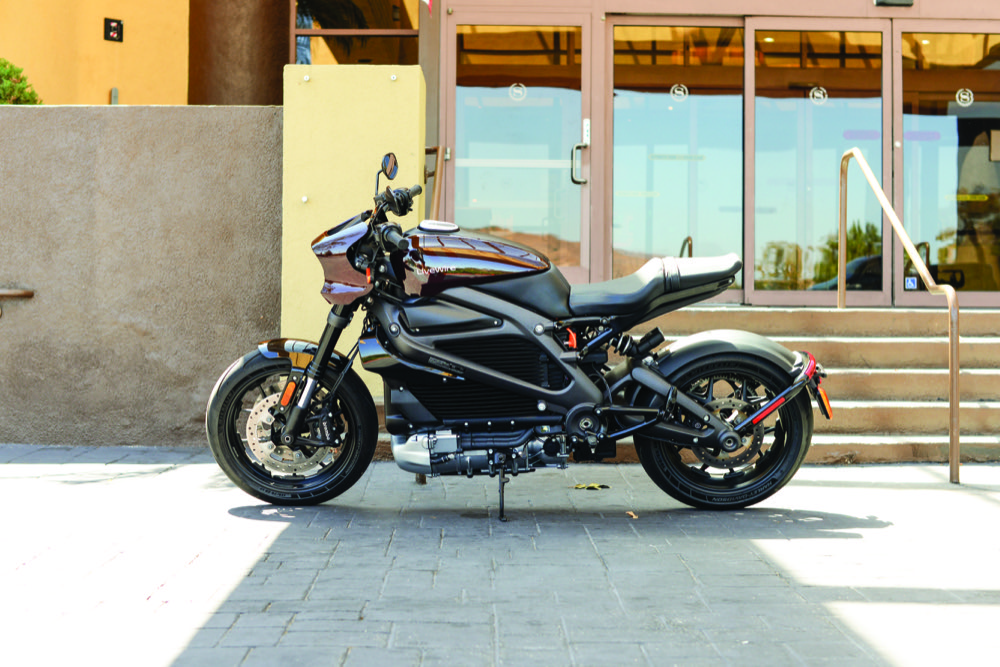Future Meets Past in Pollution-Free Hog
Story by Jay LaRossa and Mike Seate
Photos by Mike Seate and Jose Gallina
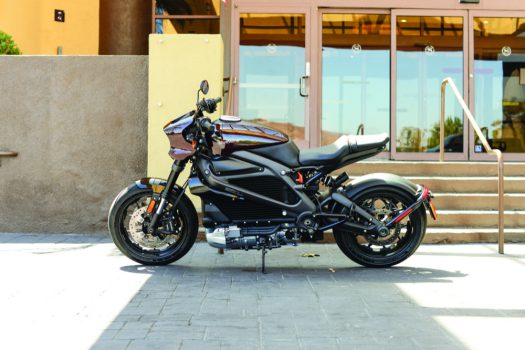
We’d been eagerly awaiting the chance to plant our leathers on Harley-Davidson’s LiveWire electric streetbike since its 2021 premiere. Switching from the fabled pushrod-operated V-twin powertrain to a platform that’s powered only by batteries was the boldest move yet from America’s largest motorcycle maker. What would the chaps-and-beards crowd make of a Hog bereft of the beloved potato-potato exhaust note? Are there enough ecologically-conscious bikers on the roads to make this $23,000 machine (if you can refer to it in those terms) viable? While contemplating these and other questions about the LiveWire’s place and purpose, we had to admit it’s one damn fine-looking two-wheeler.
“It’s really sporty-looking and I like the way they made it narrow at the tank and seat junction so it doesn’t have that big, fat, bloated feel. It’s a neat-looking bike for how big it is. There’s a definite retro vibe going on with the cooling fins around the batteries where the engine should be,” Jay laughed.
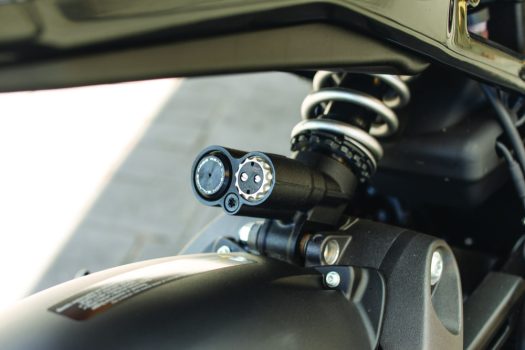
He’s right, the deep burgundy paint and black-finished cast aluminum frame flow nicely with the ersatz-Sportster “fuel tank” which, of course, is just a dummy holding the charging software. There are more fine design cues from the upside-down Showa adjustable forks to the very Buck Rogers-era, haptic pulse “engine” located beneath the massive battery compartment. The unit actually transfers the electric battery power to the one-speed gearbox, which emits a low-level vibration to helps us carbon-footprint cavemen from feeling as if we’re riding a Dyson vacuum cleaner.
Also noteworthy is the seat’s junction with the bodywork. The leather wraps smoothly around the faux tank, creating a tasteful merge point and providing a belly pad for riders to lean into when the going gets aggressive.
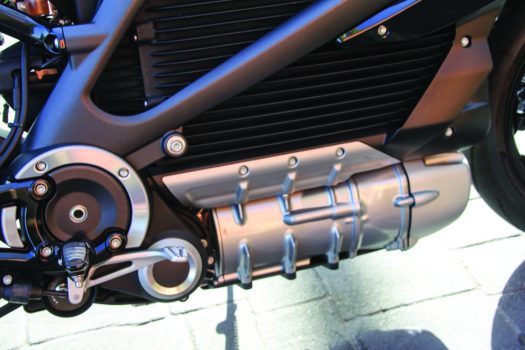
Which is just what Jay was determined to do on the LiveWire, figuring the seamless acceleration he’d heard about was something to experience for himself.
In a high-pitched whine he was off, the only audible sound being the tires contacting the high-temp So Cal pavement. On the move, the LiveWire remains a sharp-looking specimen (notice I didn’t say machine) as it’s designed with something of a traditional H-D profile. The bike is long, low-slung and perfectly proportioned, with passing Harley riders all recognizing the brand – if not the specific model – and waving in recognition.
“The acceleration is super fun and neat and it doesn’t handle bad at all. You can feel that it’s heavy especially when you sling it around into corners, but it likes corners,” Jay said after his first 20-mile session. “It’s just weird not having a clutch or a shifter. It feels like you’re on a Barbie Power Wheels bike, only it’s super-fast.” The powerband is instantly accessible, with the full 86 foot-pounds of torque on tap the moment the right twistgrip is rotated.
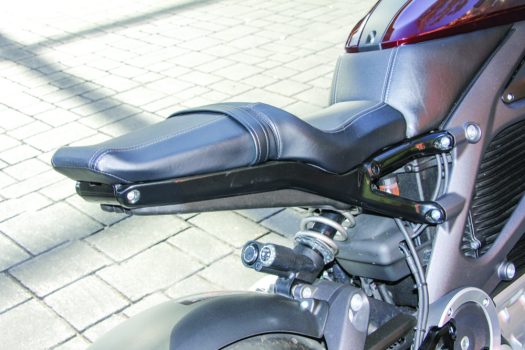
On my first ride, I realized the accuracy of Jay’s words – the absence of gears to shift meant the LiveWire rockets from zero to ‘sorry, sorry officer, I didn’t see the speed limit sign” faster than anything this side of a 200-horsepower hyperbike. Due to its considerable 549-pound heft, the feeling of mass is always present, bringing to mind the Kawasaki supercharged H2 we tested last year.
But the Harley carries its weight lower in the frame than the top-heavy Kaw, making transitions in sharp turns more efficient – to a point. Where the going really gets weird is when approaching a freeway off-ramp or a decreasing radius turn. My left foot instantly begins flailing about for a non-existent shifter while the absence of a clutch lever feels equally strange. Without any engine braking to slow the bike for an approaching corner, it’s heavy on the brakes as all 549 pounds make themselves evident as the LiveWire zooms through a corner.
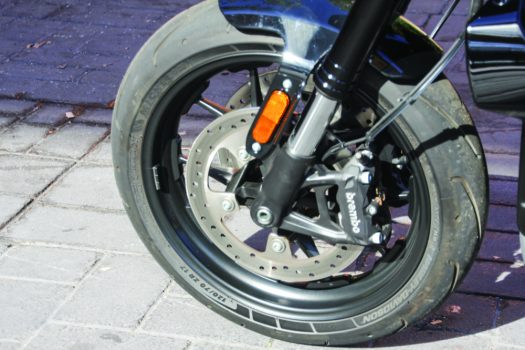
That will take some serious getting used to as overcooking a turn in what feels like top gear is a bit scary in the seat of one’s riding jeans.
“The weight is carried way down low, but pushing this thing into a corner – man, that’s a weird feeling. It’s wild how completely silent it is, too. A lady backed out of a driveway right into my path and when I yelled at her, I realized she could hear every swear word because there’s no engine noise,” Jay said.
He compared the silent progress of the LiveWire to flying an ultralight aircraft. “Just the sound of the wind and nothing else to occupy your mind.” I actually found the quiet to be peaceful, though I never before realized how much noise the wind could make at 80 MPH.
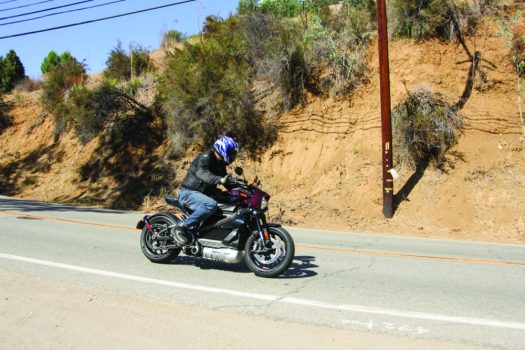
Despite its sheer differentness, the LiveWire should feel familiar to anyone who’s ridden a late-model Harley. The mirrors do a perfect job of reminding you when a Dodge Ram is bearing down from behind and the brake lever, switchgear and 1” thick handlebar are all standard-issue H-D. The long, flat LED taillight is integrated into the wrap-around rear fender – which will likely be removed by about 90% of owners in a matter of days.
The batteries have a five-year warranty and are cooled by a radiator shrouded in a nifty black cover on the frame’s downtubes. There’s a Kevlar belt final drive and fat 17” mag wheels wearing sporty Michelin radial tires, made specifically for the LiveWire. The rear shock is also fully adjustable, and if that seems like overkill on what’s essentially a very fast commuter bike, Jay noted that he’s seen these electric missiles being raced to great effect at Willow Springs.
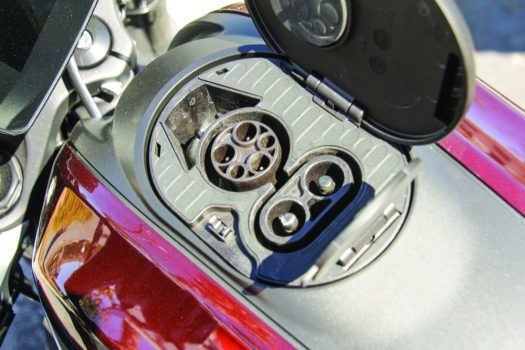
“If you can focus on what it does well, and that’s going really fast with not much rider input, these things are doing all right on the track,” he said. “The problem is, I like shifting gears and controlling a bike manually and this is like brainless transportation.”
There’s loads of tech including wheelie control, five riding modes, traction control and ABS and the full-color dash is filled with endless technical data. For those so inclined, the dash can merge with a smartphone to make Bluetooth music and phone calls (why??) available on the go. But go is another area where the LiveWire’s technology plays a poor hand. For all its strengths, the mileage from a full battery charge is just 140-odd miles, though the faster we ran our test bike, the more quickly the “distance remaining” dwindled. At highway speeds (70 MPH) the range is just 70 miles so a weekend carving up canyon roads could suddenly be cut short by a need to recharge your LiveWire. Fortunately, the bike can be recharged at many service stations, H-D dealers and supermarkets in just an hour. A supplied power cord means the LW can be topped off at home, though this takes up to 11 hours. At any rate, it’s best to keep an eye on the power level as this is definitely not a motorcycle I’d enjoy pushing home.
Still for all the adjustments required to enjoy this very capable slice of post-combustion technology, the LiveWire is a fun, expectation-dashing motorcycle to ride. “It’s not for me, but I can see where Millennials and people who just want to go fast with no mechanical maintenance would really like it,” Jay said, summing up the LiveWire ONE™ experience perfectly.
- MSRP: $22,799
- Motor: Revelation Internal permanent magnetic synchronous with water-cooling
- Powerplant: 15.5 Kilowatt hour rechargeable batteries
- Transmission: Single Speed
- Brakes: Twin radial Brembo monoblock four-piston calipers with 330mm rotors front: two-piston caliper with single 260mm rotor, rear
- Wheels: Magnesium 17×5” rear/17×3.5” front
- Tires: Michelin Scorcher radials
- Final Drive: Kevlar belt
- Suspension: 43mm adjustable Showa big piston inverted forks w 4.5” travel: Showa adjustable Balance Free Cushion Lite shock with 4.5” travel
- Power: 100 horsepower/ 86 foot-pounds torque
- Range: 140 miles at 45 MPH/ 70 miles at 70 MPH
- Charging Time: 60 minutes on DC Fast Charge, 11 hours at home
- Electronics: Five riding modes, ABS, Bluetooth enabled dash, traction control, wheelie control
- Colors: Black, white or red (which looks like burgundy to us)
- We Dig: The Saturn rocket acceleration, styling
- We’d Ditch: The paltry high-speed range
